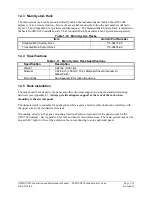
G900X/G950 Installation and Maintenance Manual – G900X/G950 Installation Overview
Page 1-29
190-00719-00
Revision D
1.6.7
Transponder Antenna Location
The antenna installation should be installed in accordance with AC 43.12-2A Chapter 3. Note that
penetration of the pressure vessel on the pressurized aircraft requires additional data not contained in this
manual.
A. The antenna(s) (Garmin P/N 010-10160-00) or equivalent should be mounted away from
major protrusions, such as engine(s), propeller(s), and antenna masts. It should also be as far
as practical from landing gear doors, access doors, or other openings that could affect the
radiation pattern.
B. The antenna should be mounted vertically on the bottom of the aircraft.
C. Avoid mounting the antenna within three feet of the ADF sense antenna or any other
communication antenna and six feet from the DME antenna.
D.
To prevent RF interference, the antenna must be physically mounted a minimum distance of
three feet from the GTX 33.
NOTE
If the antenna is being installed on a composite aircraft, sufficient ground plane material
must be added. Conductive wire mesh, radials, or thin aluminum sheets embedded in the
composite material provide the proper ground plane allowing the antenna gain pattern to
be maximized for optimum transponder performance.
The maximum coaxial cable attenuation at 1090 MHz must not exceed 1.5 dB, including connectors. In
the diversity installation the cable loss characteristics must be the same within ±0.1 dB (cables within
4 inches of the same length should have less than 0.1 dB difference in their loss characteristics).
Table 1-17 lists some suitable cable types, along with the maximum length based on an assumed loss
figure of 0.2 dB per connector. Any 50
Ω
, double shielded coaxial cable assembly that meets
airworthiness requirements and the 1.5 dB maximum loss figure (including connectors) may be used.





































